External wall insulation requires thorough preparation and professional expertise. You’ll need a qualified surveyor to assess your property’s structural integrity and determine insulation requirements. The process involves cleaning exterior surfaces, repairing damage, installing support frameworks, and applying insulation boards with proper adhesives and mechanical fixings. You’ll also need to secure building permits and comply with local regulations. Understanding the complete installation sequence will guarantee maximum thermal efficiency and long-term performance.
Key Takeaways
- Survey your property for structural issues, dampness, and necessary repairs before beginning the installation process.
- Clean exterior walls thoroughly with pressure washing and repair any cracks or damage before applying insulation.
- Install support systems using timber battens or aluminum rails, ensuring precise alignment with 400-600mm spacing.
- Apply insulation boards in a staggered pattern with proper adhesive coverage and mechanical fixings around windows and doors.
- Perform regular quality checks during installation and establish a maintenance schedule for cleaning and inspecting the insulation system.
Initial Property Assessment and Survey
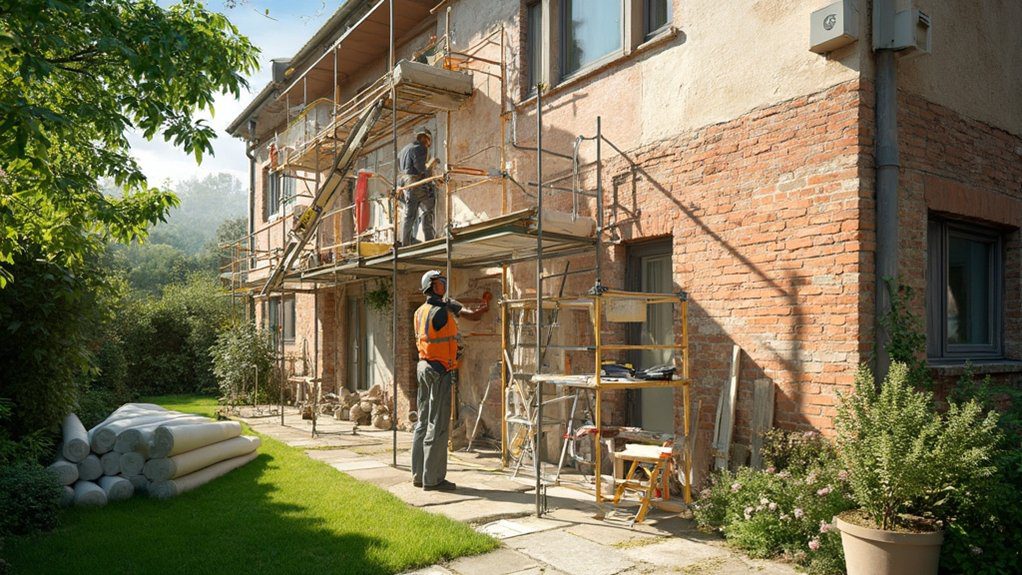
A thorough property assessment serves as the critical first step before installing external wall insulation.
You’ll need a qualified surveyor to evaluate your home’s structural integrity, existing wall composition, and overall property condition. They’ll examine your exterior walls for damage, damp issues, or necessary repairs that must be addressed before installation begins.
During this assessment, your surveyor will determine specific insulation requirements based on your property’s construction type, local climate conditions, and building regulations.
They’ll measure wall dimensions, identify potential challenges around windows and doors, and assess fixing methods suitable for your wall type.
You’ll also receive guidance on ventilation needs, as proper airflow must be maintained once the insulation is installed.
This detailed evaluation guarantees your installation plan meets both technical specifications and regulatory compliance.
Choosing the Right Insulation Materials
When selecting external wall insulation materials, you’ll need to evaluate several key thermal and physical properties that directly impact performance. The most common types of insulation include expanded polystyrene (EPS), mineral wool, and polyisocyanurate (PIR) boards, each offering different benefits for your home’s specific needs.
Consider your insulation’s R-value, which measures thermal resistance, along with factors like moisture resistance, fire safety ratings, and durability.
EPS provides excellent cost-effectiveness and lightweight properties, while mineral wool offers superior fire resistance and soundproofing.
PIR boards deliver the highest insulation performance per unit thickness, making them ideal for properties with limited external space.
Your choice should align with your local climate conditions, building regulations, and budget while ensuring peak thermal efficiency for your home.
Planning and Building Regulations
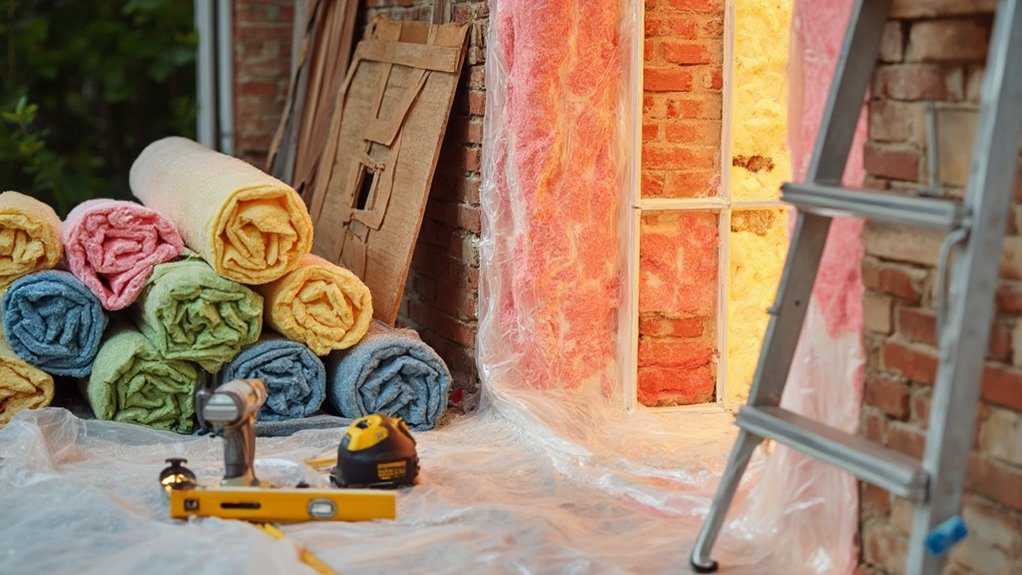
Before undertaking any external wall insulation project, you’ll need to secure proper approvals and comply with local building regulations. Check with your local authority to determine if you need building permits, as requirements vary by location and property type.
Listed buildings and homes in conservation areas often face stricter regulatory compliance standards.
You’ll need to submit detailed plans showing the insulation system’s specifications, including materials, thickness, and fixing methods. Your plans must demonstrate compliance with thermal performance requirements and fire safety standards.
Don’t forget to assess the impact on your property’s external appearance and how it affects neighboring buildings.
Ensure your chosen installer understands current building regulations and can provide necessary certificates upon completion. They should help you navigate the approval process and maintain proper documentation throughout the project.
Preparing Your Home’s Exterior
Proper exterior preparation forms the foundation of a successful external wall insulation installation. You’ll need to thoroughly assess your walls’ condition before proceeding with any work.
Start with a thorough structural assessment to identify cracks, damp patches, or deteriorating mortar that could compromise the insulation’s effectiveness.
Begin exterior cleaning by removing all dirt, algae, and loose materials using a pressure washer. You’ll want to detach exterior fixtures like downpipes, satellite dishes, and outdoor lighting to guarantee complete coverage.
It’s crucial to repair any identified structural issues and allow the walls to dry completely before installation begins. If you’ve got old render, test its bond strength and remove any loose sections.
Remember to protect windows and doors with appropriate covering during the preparation phase.
Installing the Support Framework

The support framework serves as the critical foundation for your external wall insulation system. You’ll need to choose between timber battens or aluminum rail systems based on your wall’s condition and insulation requirements.
| Framework Type | Installation Technique |
|---|---|
| Timber Battens | Direct fixing to wall with mechanical anchors |
| Aluminum Rails | Bracket mounting with thermal breaks |
| Hybrid Systems | Combination fixing with adjustable brackets |
During installation, you’ll want to guarantee precise vertical and horizontal alignment using laser levels. Spacing between support components typically ranges from 400mm to 600mm, depending on your insulation board specifications and local building codes. The framework must be thoroughly secured to handle both the insulation system’s weight and potential wind loads. You’ll also need to incorporate expansion joints at strategic points to accommodate thermal movement.
Applying the Insulation Boards
With your support framework securely in place, applying insulation boards requires methodical attention to detail and precise positioning.
You’ll need to select from various insulation board types, including expanded polystyrene (EPS), mineral wool, or phenolic boards, based on your home’s specific requirements.
Start at the bottom of your wall and work upward, using a staggered pattern to prevent thermal bridging.
You’ll apply adhesive to the boards using the dot and dab insulation application technique, ensuring 40% coverage of each board’s surface.
Position boards tightly against each other, checking for gaps that could compromise thermal efficiency.
Secure them with mechanical fixings – typically 5 per square meter.
Cut boards precisely around windows, doors, and service penetrations using a fine-toothed saw.
Remember to check each board’s level and alignment as you progress.
Reinforcement and Weather Protection
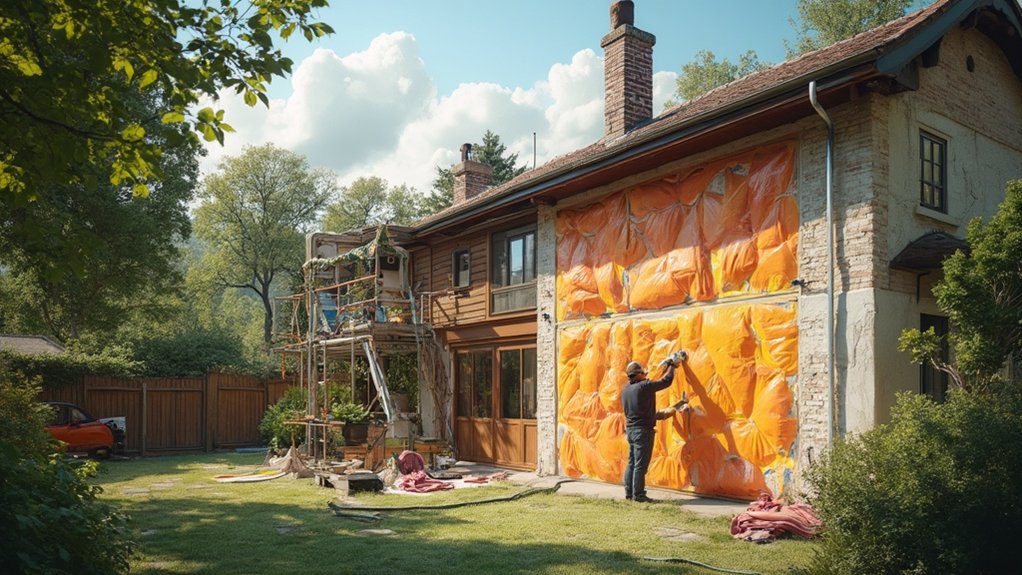
Safeguarding your external wall insulation requires a robust reinforcement mesh system and weather-resistant finish.
You’ll need to embed fiberglass reinforcement materials into a base coat of render, ensuring complete coverage across all insulation boards. This mesh strengthens the system and prevents cracking from thermal movement or impact.
Once the base coat’s dried, you’ll apply specialized weather barriers in the form of a final render coat. This protective layer needs to be vapor-permeable while remaining waterproof, allowing your walls to breathe while keeping moisture out.
You’ll want to choose a finish that’s compatible with your climate zone – silicone-based renders work well in areas with high rainfall, while mineral renders suit drier conditions.
Pay special attention to corners, joints, and window reveals, as these areas need extra reinforcement to prevent future issues.
Final Rendering and Finishing Touches
Building upon your weatherproofing layers, proper rendering creates the final aesthetic appeal while maintaining protection.
You’ll need to apply multiple coats of render, allowing each layer to cure completely before proceeding. The base coat provides essential adhesion, while the finish coat determines your wall’s final appearance.
For aesthetic options, you can choose between smooth, textured, or patterned finishes. Modern renders come in various colors and compositions, eliminating the need for additional painting.
Your final touches should include sealing around windows, doors, and other penetrations with appropriate weatherproof sealants. Don’t forget to install proper drip edges and corner beads for clean, professional-looking edges.
Once completed, you’ll have transformed your home’s exterior while creating an efficient thermal envelope that’ll serve you for years to come.
Quality Control and Inspection
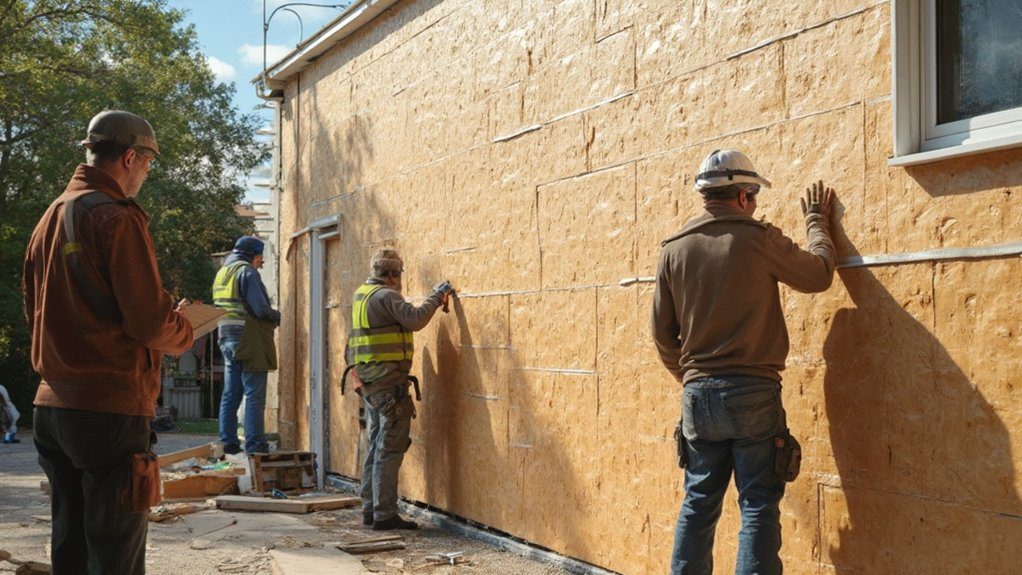
Throughout the installation process, regular quality control checks and inspections are vital to assure your external wall insulation system meets industry standards and building regulations.
You’ll need to make certain that your contractor follows strict inspection protocols at significant stages, including substrate preparation, insulation board fixing, base coat application, and final render.
Your installer should document each quality control checkpoint, measuring adhesive coverage, checking board alignment, and verifying reinforcement mesh positioning.
They’ll test the surface for flatness and inspect all joints, edges, and corners.
You’ll want to confirm they’re following manufacturer-specified quality standards for material mixing ratios and application temperatures.
Request a final inspection report that details moisture readings, adhesion tests, and overall system compliance.
This documentation’s critical for warranty validation and future reference.
Aftercare and Maintenance Guidelines
To maximize the lifespan of your external wall insulation system, you’ll need to implement a regular maintenance routine and follow specific aftercare protocols. Your insulation longevity depends on consistent inspection and timely repairs.
| Maintenance Task | Frequency | Action Required |
|---|---|---|
| Visual Inspection | Monthly | Check for cracks, damage |
| Cleaning | Bi-annually | Wash with mild detergent |
| Joint Review | Annually | Inspect seals, sealants |
| Impact Assessment | Quarterly | Look for physical damage |
| Drainage Check | Bi-annually | Clear gutters, outlets |
Establish a maintenance schedule that includes regular cleaning to prevent algae growth and dirt accumulation. You’ll need to address any damage promptly to prevent moisture infiltration. When you notice cracks or deterioration, contact your installer immediately. Remember, proper maintenance now prevents costly repairs later and guarantees your insulation system performs efficiently for years to come.
Frequently Asked Questions
Can I Install External Wall Insulation if I Live in a Listed Building?
You’ll need special permission due to listed building regulations before installing external insulation. Due to preservation requirements and insulation installation challenges, you’ll likely face significant restrictions or may not receive approval at all.
Will External Wall Insulation Affect My Home’s Satellite TV Reception?
You’ll need to evaluate possible satellite interference. While external wall insulation can affect signal quality, your installer can help relocate your dish or adjust its position to maintain ideal reception.
How Long Does External Wall Insulation Typically Last Before Needing Replacement?
You’ll find that properly installed external wall insulation has an installation lifespan of 25-30 years. With regular maintenance requirements like annual inspections and prompt repairs, you can extend its effectiveness beyond these typical timeframes.
Can External Wall Insulation Be Painted With Any Type of Exterior Paint?
Like choosing the perfect outfit, you can’t use just any paint on your external wall insulation. You’ll need specialized breathable exterior masonry paints that work with your insulation colors and protect the system’s functionality.
Does External Wall Insulation Help Reduce Outside Noise Entering My Home?
Yes, you’ll notice significant noise reduction benefits from external wall insulation. It creates a solid barrier that dampens outside sounds, typically reducing noise levels by 8-10 decibels, making your home’s interior considerably quieter.
Conclusion
Installing external wall insulation transforms your home like a butterfly emerging from its cocoon. You’ll need to maintain regular inspections of the finished system, checking for any cracks or damage at least twice yearly. Keep drainage points clear, clean the surface periodically, and address any issues immediately to protect your investment. When properly maintained, your external wall insulation system will deliver superior thermal performance for decades to come.

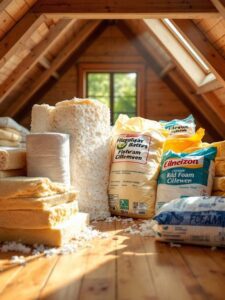
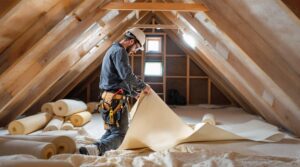
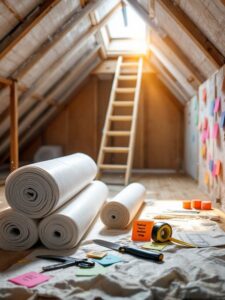
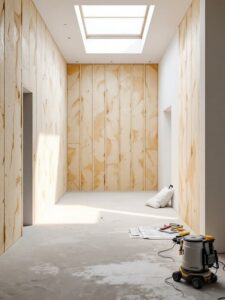



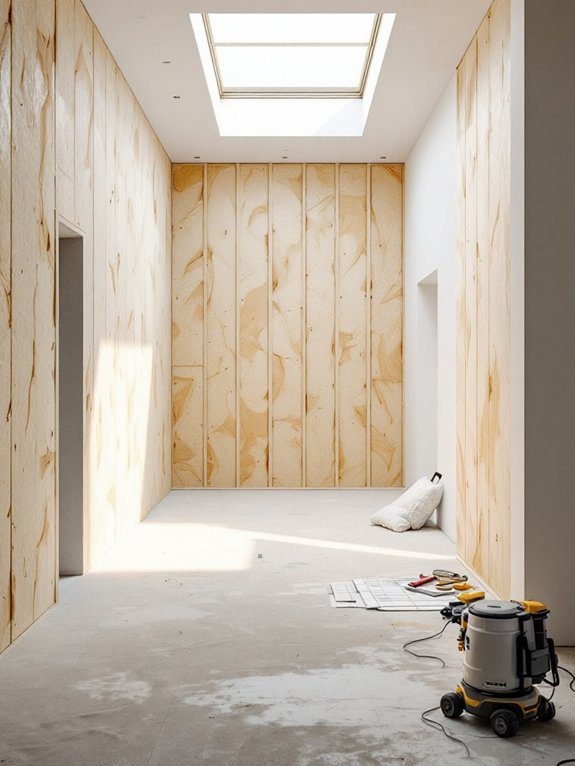
2 Responses
Excellent blog here! Also your web site loads up very fast! What web host are you using? Can I get your affiliate link to your host? I wish my website loaded up as quickly as yours lol
Great post. I am facing a couple of these problems.